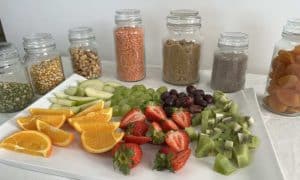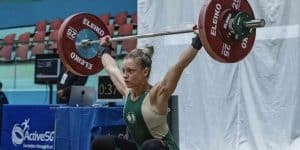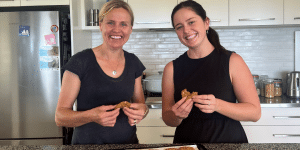How flexible are you?

“I’ve never been flexible”…
Does this sound familiar? While some people are inherently more flexible than others, and younger age and female gender certainly help, it’s something that is trainable. This month we cover a few questions;
- What is flexibility?
- Can you be too flexible?
- How much is enough?
What is flexibility?
Flexibility is the muscle’s ability to lengthen. Mobility is the ability to move your joints freely and easily through their full range of motion. To be mobile you do need good flexibility – in addition to strength and coordination.
For example, mobility is when you bring your knee towards your chest without assistance. When you place your hands on your knee and pull it closer to your chest this demonstrates the hips overall flexibility.
Can you be too flexible?
Too much flexibility can come at the cost of stability. In this context, stability is your capacity to keep the opposing sides of your joints held snugly together. A lack of stability can cause joints to dislocate or sublux (which is when they almost dislocate). It can also accelerate the onset of arthritis because the extra joint movement causes the cartilage to wear away more quickly. Like most things in the body, a balanced approach works best – flexibility plus strength plus good coordination is the ideal combination.
How do you measure up?
It’s time to compare yourself to your friends, partner, kids or teammates. We’ve got 3 simple tests below along with some population data to illustrate where you sit on the flexibility scale.
Shoulder reach test for shoulder mobility.
Method:
- Place one hand behind your head over your shoulder. Reach down as far as possible with your palm facing your body and fingers pointing downward.
- At the same time, place the other hand behind your back. Reaching up as far as possible with you palm facing outward and fingers pointing upward.
- Attempt to touch or overlap your fingers. Measure the overlap distance (scored as a positive number) or if unable to touch, the distance between your fingers (scored as a negative number).
- You’ll probably find that your best result is when your dominant hand is the one coming down from behind your head – use your best result to compare against the scoring table below.
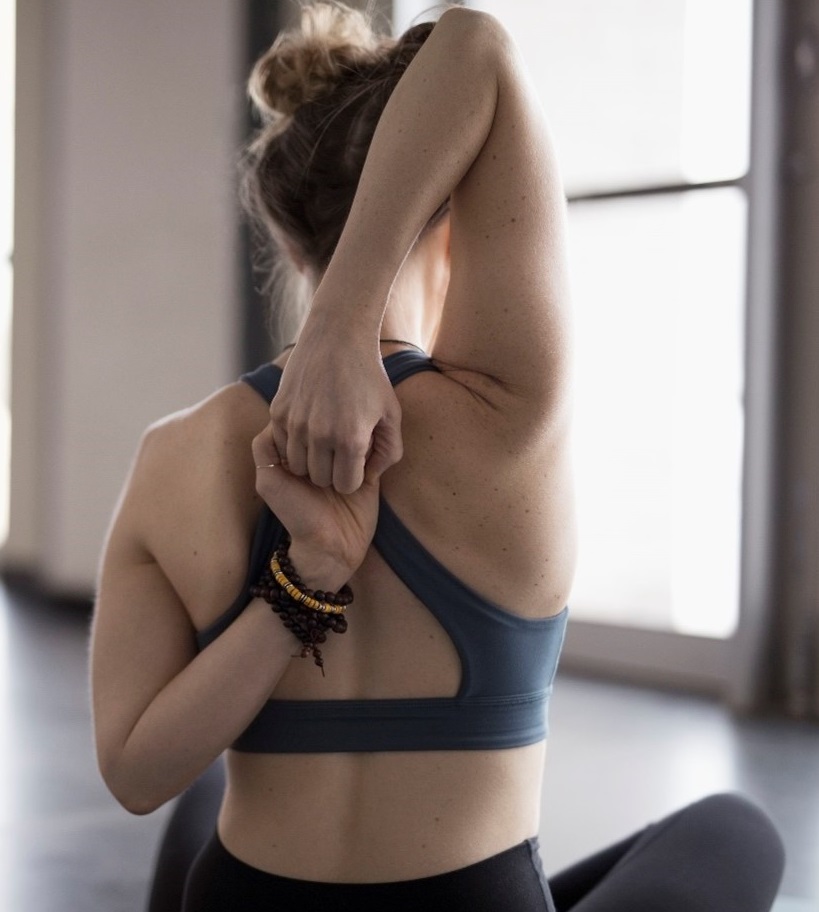
Males
| 20-30yrs | 30-40yrs | 40-50yrs | 50-60yrs | 60-65yrs | |
|---|---|---|---|---|---|
| Bottom 25% | <-3.9cm | <-8.5cm | <-15.1cm | <-18.5cm | <-23.0cm |
| Average | -0.2cm | -3.1cm | -7.7cm | -11cm | -16.6cm |
| Top 25% | >4.8cm | >3.7cm | >-0.5cm | >-4.5cm | >-9.8cm |
Females
| 20-30yrs | 30-40yrs | 40-50yrs | 50-60yrs | 60-65yrs | |
|---|---|---|---|---|---|
| Bottom 25% | <-3.9cm | <-1.5cm | <-7.8cm | <-9.0cm | <-11.0cm |
| Average | -1.1cm | -1.8cm | -2.2cm | -5.2cm | -5.8cm |
| Top 25% | >6.4cm | >7.0cm | >-3.9cm | >0cm | >0cm |
Source: Kjaer et al (2016). Normative values for musculoskeletal- and neuromotor fitness in apparently healthy Norwegian adults and the association with obesity: a cross-sectional study. BMC Sports Sci Med Rehabil. 2016; 8: 37.
Sit and Reach test for flexibility of hamstrings and lower back
Method:
- Sit on the floor (shoes and socks off) with legs straight out in front of you, feet flat against a step
- Both knees locked, one hand on top of the other, palms facing downwards
- Slowly reach forward as far as possible.
- Record the distance you can reach past the edge of the step / your toes (a positive number, per the image below) or how far short you are from the step (a negative number).
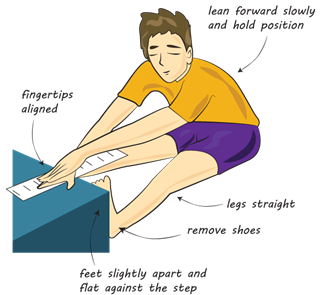
Male
| 20-30yrs | 30-40yrs | 40-50yrs | 50-60yrs | 60-65yrs | |
|---|---|---|---|---|---|
| Bottom 25% | <-7cm | <-10.0cm | <-12.4cm | <-15.0cm | <-14.0cm |
| Average | -2.2cm | -1.9cm | -2.8cm | -6.5cm | -6.2cm |
| Top 25% | >5.4cm | >8.6cm | >7.4cm | >2.5cm | >2.0cm |
Female
| 20-30yrs | 30-40yrs | 40-50yrs | 50-60yrs | 60-65yrs | |
|---|---|---|---|---|---|
| Bottom 25% | <-4.0cm | <-1.0cm | <-8.0cm | <-7.0cm | <-8.5cm |
| Average | -1.4cm | 6.0cm | -1.7cm | -0.8cm | -1.9cm |
| Top 25% | >10.8cm | >15.5cm | >8.5cm | >7.9cm | >9.0cm |
Source: Kjaer et al (2016). Normative values for musculoskeletal- and neuromotor fitness in apparently healthy Norwegian adults and the association with obesity: a cross-sectional study. BMC Sports Sci Med Rehabil. 2016; 8: 37.
Knee to wall test for ankle mobility
Method:
- Place a ruler on the floor with the zero touching the wall.
- Test your right foot by placing it next to the ruler, per the image below. Start with your big toe about 5cm back from the wall. Your left (back) foot can go wherever is comfortable.
- Keeping the heel of the front foot on the ground, try bend your right knee and touch the wall. If you can reach the wall, move your foot back further from the wall and try again. Keep going until you are no longer able to touch the wall without your right heel lifting up.
- The last distance you could touch the wall at is your result. Repeat on the opposite side. An asymmetry of up to approx. 2cm is normal.
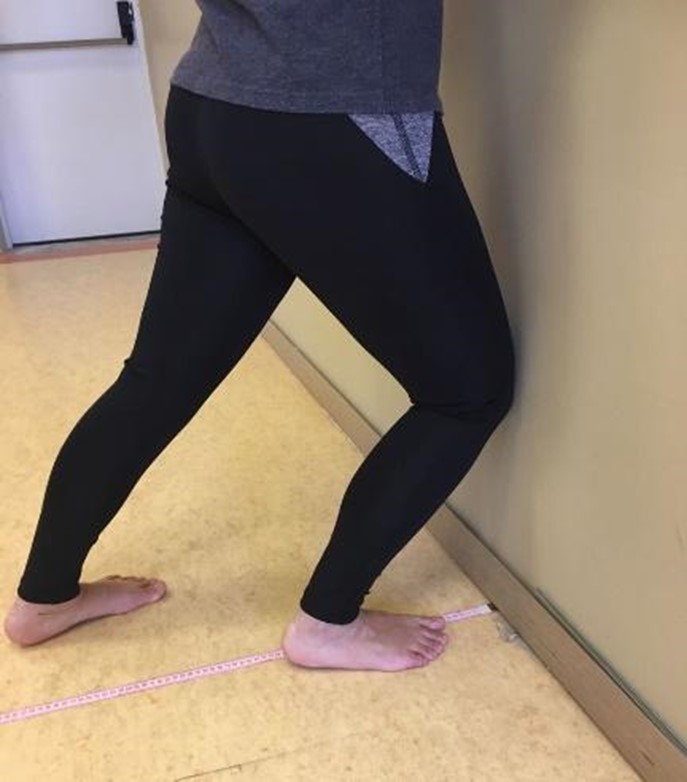
How do you rate?
| Excellent mobility | 10cm+ |
| Good mobility | 10cm |
| Poor ankle mobility | <5cm |
Source: Easy Knee to Wall Test To Check Flexibility | PhysioFit Health
Would you like to improve your flexibility, or address that niggle that stops you doing some of the tests? Our Physiotherapists and Exercise Physiologists at our Newcastle and Lake Macquarie practices can help; contact us on (02) 4962 8700 for an appointment, or book online. We look forward to seeing you soon!


